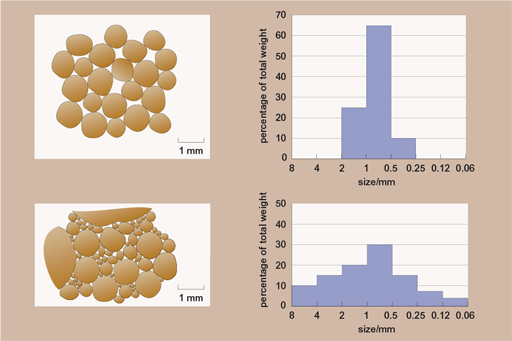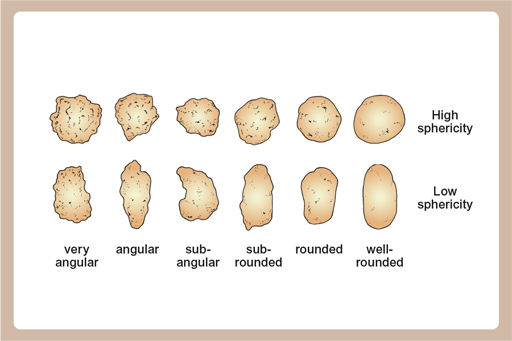2.9 The geological sorting hat
The breaking down and winnowing of material as rocks are weathered and transported is an important sedimentary process, and introduces two important concepts for geologists – sorting and roundness.
As sedimentary materials are transported and deposited, usually by water and wind in the case of sands, there’s a tendency for the particles to be sorted into different sizes. This degree of sorting depends mainly on how particles of different size and density settle through the current carrying them along (whether wind or water). The more uniform the conditions in the environment of deposition, the better sorted the sediment will be.
This is due to two important factors – water and wind only have the power to transport material up to a certain mass. What’s left behind is the material which is right on the limit of what the fluid can carry – any lighter and it will be carried away, and any heavier and it won’t be there in the first place.
In sedimentary systems, the grain size of the material left behind can tell us how much energy was in the fluid at the time of deposition, and how well sorted the material is tells us whether the deposition happened quickly, or slowly.
Figure 2.8 shows two different sorts of sediment. The well sorted sediment in the upper image has lots of grains of the same size which might result from a long period of gentle washing back and forth, caused by low-energy waves on a beach or by desert sand being blown by a steady wind. A poorly sorted sediment like the one in the lower image has grains of lots of different sizes, which are jumbled together. This tends to happen when sediments have been deposited in very variable conditions or very quickly, like in a landslide or a flash flood.
The other thing that happens during transport is that the grains collide with each other. They might start out as perfectly formed crystals in an igneous or metamorphic rock, but as they are transported the corners can be knocked off, pits gouged into them and the surfaces of the grains pitted. Geologists can look at sedimentary rocks and define the roundness of the grains, which can tell us things about how far and for how long material has been transported, and by what means. For example, the air in a desert doesn’t cushion the grains nearly as well as water can, so sands which form in deserts tend to have much better-rounded grains than those that are transported by rivers. Figure 2.9 shows some of the sorts of terms geologists use to describe the different shapes of grains, and shows how different they can be.
The deposition leaves other clues about the environment in the rock record. This can be things like bedding, flat lines, which show how layer upon layer of material has been laid down over time, or ripples, just like the ones you see on a beach or river bed today, preserved for millions of years. Fossils can also be left behind – either evidence like burrows, which tell us that something used to live in the sand, or fossilised shells, which can give us important clues about what it was like when the sands were deposited.


